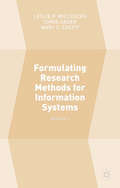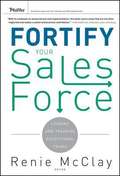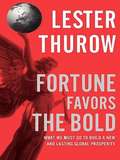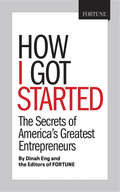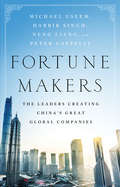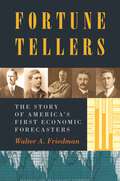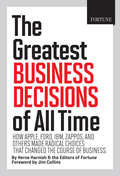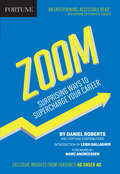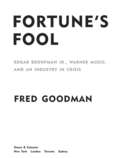- Table View
- List View
Formulating Research Methods for Information Systems: Volume 1
by Leslie P. Willcocks Mary C. Lacity Chris SauerThis edited two-volume collection presents the most interesting and compelling articles pertaining to the formulation of research methods used to study information systems from the 30-year publication history of the Journal of Information Technology .
Formulating Research Methods for Information Systems: Volume 2
by Leslie P. Willcocks Mary C. Lacity Chris SauerThis edited two-volume collection presents the most interesting and compelling articles pertaining to the formulation of research methods used to study information systems from the 30 year publication history of the Journal of Information Technology (JIT).
Formulating a Strategic Blueprint for Action: How State Street Reinvented Its Business and How the Axe Brand Redefined an Entire Category
by Erich JoachimsthalerCompanies that do not explicitly define, structure, analyze, and prioritize their opportunity spaces often chase romantic dreams about big ideas and breakthrough products or services, but fail to realize those dreams. This chapter describes how State Street and Axe brand created strategies that guided the activation of new growth platforms from the highest strategic level all the way to activation in customers' everyday lives.
Formulation Simplified: Finding the Sweet Spot through Design and Analysis of Experiments with Mixtures
by Mark J. Anderson Patrick J. Whitcomb Martin A. BezenerMany chemists – especially those most brilliant in their field – fail to appreciate the power of planned experimentation. They dislike the mathematical aspects of statistical analysis. In addition, these otherwise very capable chemists also dismissed predictive models based only on empirical data. Ironically, in the hands of subject matter experts like these elite chemists, the statistical methods of mixture design and analysis provide the means for rapidly converging on optimal compositions. What differentiates Formulation Simplified from the standard statistical texts on mixture design is that the authors make the topic relatively easy and fun to read. They provide a whole new collection of insighful original studies that illustrate the essentials of mixture design and analysis. Solid industrial examples are offered as problems at the end of many chapters for those who are serious about trying new tools on their own. Statistical software to do the computations can be freely accessed via a web site developed in support of this book.
Foro Energy (A)
by William A. Sahlman Joseph B. Lassiter James McquadeForo Energy developed proprietary and patent-pending fiber-laser technologies that could disrupt existing processes and services for the exploration and production of oil and natural gas. These breakthrough laser technologies were protected by a strong intellectual property (IP) portfolio, which provided Foro with the flexibility to pursue a number of different business models. The market potential for oilfield applications was large, as global spending in the O&G E&P industry was expected to approach $600 billion in 2012.
Forschen – Patentieren – Lizenzieren: Aus der Wissenschaft über Patentschutz bis zur Spin-off-Gründung
by Kirstin SchillingDieser Ratgeber erklärt, wie Forschungsergebnisse aus Universitäten und Hochschulen patentiert und lizenziert oder verkauft werden können. Wichtige Aspekte des Erfindungs-, Patent- und Lizenzrechts werden anhand von Beispielen erläutert.Im ersten Teil werden Fragen beantwortet, was eine patentierbare Erfindung ist und welche Erfindervergütung Forschenden an Hochschulen zusteht. Ausführlich behandelt wird u.a. das Thema, wie Forschungsergebnisse publiziert und trotzdem patentiert werden können.Im zweiten Teil, speziell zum Patentieren, wird gezeigt, wie eine Patentanmeldung aufgebaut ist, wie Patentprüfverfahren ablaufen und was sie kosten. Mit vielen Praxistipps wird erklärt, wie man eine Patentrecherche durchführt und ermittelt, ob ein Patent noch aktiv ist. Zudem wird erläutert, welche Besonderheiten beim Schutz von Erfindungen für medizinische Anwendungen zu beachten sind.Im dritten Teil werden verschiedene vertragliche Lösungen zur Anbahnung sowie zum Abschluss von Lizenz- und anderen Verwertungsvereinbarungen vorgestellt. Häufige Probleme bei der Finanzierung der Weiterentwicklung von Projekten werden adressiert und Lösungen aufgezeigt. Der Schlussteil ist speziell dem Thema der Gründung von akademischen Spin-off-Unternehmen gewidmet. Die aktualisierte und erweiterte 2. Auflage enthält neue Beiträge zu den Themen Software-Schutz und -Lizenzierung und zu den Möglichkeiten, patentgeschützte Technologien weiterzuentwickeln. Neue Beispiele sowie verlinkte Interviews mit Experten illustrieren Best-practice-Fälle.Das Buch eignet sich sowohl als Übersicht für Einsteiger als auch zum gelegentlichen Nachschlagen für gestandene Erfinder. Es richtet sich grundsätzlich an alle Forschenden in den Naturwissenschaften und der Medizin sowie Mitarbeitende des Technologietransfers an Universitäten, Universitätskliniken und Hochschulen. Videos per App: einfach die SN More Media App kostenfrei herunterladen, ein Bild oder einen Link mit dem Play-Button scannen und sofort das Video auf Smartphone oder Tablet ausspielen.
Forschen – Patentieren – Verwerten: Ein Praxisbuch für Naturwissenschaftler mit Schwerpunkt Life Sciences
by Kirstin SchillingDieses Praxisbuch erklärt, wie Forschungsergebnisse von Wissenschaftlern aus Universitäten und Hochschulen patentiert und kommerziell verwertet werden können. Wichtige Aspekte des Erfinder- und Patentrechts werden anhand von Beispielen erläutert und es finden sich praktische Tipps, etwa zur Durchführung von Patentrecherchen oder zur Gründung von Spin-off-Unternehmen.Aus dem Inhalt:Was ist ein Patent und wie sieht es aus?Neuheits- und PatentrechercheWelche Forschungsergebnisse können patentiert werden?Patentieren und PublizierenAblauf und Kosten von PatentverfahrenErfinderrechte, Erfinderpflichten & ErfindervergütungIP-Rechte in ForschungskooperationenGeheimhaltungsvereinbarung & MaterialaustauschvereinbarungLizensieren oder Verkaufen von PatentenDas Buch eignet sowohl als Übersicht für Einsteiger, als auch zum gelegentlichen Nachschlagen für gestandene Erfinder. Es richtet sich grundsätzlich an alle Naturwissenschaftler und Mediziner an Universitäten, Universitätskliniken und Hochschulen. Viele Beispiele entstammen dem Life-Science-Bereich, so dass besonders Biologen, Chemiker, Pharmazeuten und Mediziner angesprochen werden.
Forschungsdesign im Bereich Betriebswirtschaft und Management: Ein praktischer Leitfaden für Studierende und Forschende
by Stefan Hunziker Michael BlankenagelDieses Lehrbuch über Forschungsdesigns bietet Bachelor- und Masterstudierenden eine detaillierte Anleitung zur Bewältigung ihrer Forschungsprojekte. Es wurde für universitäre Kurse in Deutschland, Österreich und der Schweiz empfohlen und entwickelt. Die Autoren bieten den Studierenden relevante Forschungsdesigns im Bereich Betriebswirtschaft und Management an. Sie zeigen, wie man die übliche Trennung zwischen qualitativen und quantitativen Methoden überwinden kann. Zu diesem Zweck konzentriert sich das Lehrbuch auf den wissenschaftlichen Problemlösungsprozess und betont die Bedeutung eines angemessenen Forschungsdesigns für die Erzielung intellektueller Beiträge. Die Autoren beschreiben die relevantesten Forschungsdesigns im Bereich Betriebswirtschaft und Management und bewerten jedes Forschungsdesign hinsichtlich seiner Eignung zur Beantwortung spezifischer Forschungsfragen. Das Lehrbuch behandelt auch das wissenschaftliche Schreiben und bietet wertvolle Tipps zumgesamten Forschungsprozess. Es dient den Studierenden nicht nur als Ressource zur Durchführung ihrer Forschungsprojekte, sondern ist auch ein hilfreiches Nachschlagewerk für die gesamte akademische Laufbahn.
Forschungsdesigns der Wirtschaftsinformatik: Empfehlungen für die Bachelor- und Masterarbeit (essentials)
by Dominic LindnerIn diesem Buch werden Grundlagen zur empirischen Sozialforschung erläutert und Empfehlungen zur Findung eines Themas für die Abschlussarbeit gegeben. Anschließend werden vier Forschungsdesigns vorgestellt, ergänzt durch Tipps für die Kooperation mit einem Praxispartner. Empfehlungen zum Umgang mit Themen wie Plagiat und Zitierweise runden das Essential ab. Die Inhalte sollen Studierenden aus dem Bereich der Betriebswirtschaft und der Wirtschaftsinformatik als Hilfestellung bei der Konzeption und Erstellung einer Abschlussarbeit dienen.
Forschungskoordination: Grundlagen, Vorgehensweisen und Methoden für geförderte kooperative Forschungsprojekte
by David KorteDieses Buch widmet sich der Rolle und den Aufgaben der Forschungskoordination in Unternehmen und Forschungseinrichtungen und bietet praxisorientierte Hilfsmittel wie Methoden und Checklisten für die Vorbereitung und Durchführung von Forschungsprojekten. Der Inhalt orientiert sich an den vier Aufgabenschwerpunkten der Forschungskoordination: In einem ersten Schritt widmet sich der Autor der Bedeutung der Forschung in Wissenschaft und Wirtschaft und bietet einen Überblick über die Forschungslandschaft mit den verschiedenen beteiligten Akteuren und Fördermöglichkeiten. Des Weiteren werden das Forschungsportfolio und die damit zusammenhängende Forschungsstrategie in Unternehmen oder Forschungseinrichtungen adressiert, um Hilfestellungen beim Aufbau und der Koordination von Forschungsprojekten zu geben. Dies beinhaltet verschiedene praxisnahe Methoden, die bei der Generierung und Bewertung von Ideen für Forschungsprojekte helfen. Einen wichtigen Beitrag zur Steigerung der Innovativität leisten kooperative Forschungsaktivitäten, die den dritten Aufgabenschwerpunkt der Forschungskoordination darstellen. Der Kern der kooperativen Forschung sind Forschungsprojekte – der vierte Schwerpunkt der Forschungskoordination – die über alle Phasen hinweg betrachtet werden und für die oftmals Fördermittel beantragt werden können. Neben der Vorbereitung eines Forschungsprojektes und der Beantragung der Fördermittel werden die Projektdurchführung, der Transfer von Ergebnissen sowie der Abschluss des Projektes thematisiert. In all diesen Bereichen kann die Forschungskoordination Unterstützung leisten und sich beispielsweise durch den Einsatz von Methoden oder die Nutzung von vorgefertigten Checklisten einbringen. Diese einfach anwendbaren Methoden und Checklisten finden sich in diesem Buch verteilt über die vier Kapitel. Die Zielgruppe dieses Buches sind Mitarbeitende aus der Forschung oder der Forschungskoordination von mittelständischen Unternehmen und Forschungseinrichtungen.
Fort Collins Beer: A History of Brewing on the Front Range (American Palate)
by Brea D. Hoffman Foreword By HallAlthough alcohol arrived with the first settlers in Fort Collins, Prohibition lingered until 1969. But the city was one of the first to latch onto the burgeoning craft beer movement. In 1989, Old Colorado Brewing Company paved the way as the city’s first microbrewery. And with the inception of breweries like Odell and New Belgium, local beer soon saw a strong resurgence followed by popularity nationwide. By 2010, a new generation of breweries, like Funkwerks and Equinox Brewing, emerged. Brea D. Hoffman divulges the history of Fort Collins’s evolving beer scene.
Forta Furniture: International Expansion
by John A. Quelch Karthik EaswarThe Forta Furniture case highlights the need to consider new market expansion to grow a firm. It demonstrates that simply doing what has always been done is not sustainable when other competitors enter the market with differentiated or potentially superior offerings. In addition, the case suggests there are many routes to global expansion; a firm could look to build a brand in these new markets or compete as a private label. Further, the case addresses the need to combine quantitative and qualitative analyses for making superior decisions. Additionally, this case touches on the need to understand differences in resources and customer preferences in different countries and how a company should consider these factors when defining its growth strategy in deciding whether, where, and how to expand internationally. This case can be used in an introductory marketing management course for undergraduates or MBA students that discusses new market expansion and/or global or multi-market marketing strategy. In addition, it could be used in an elective course on international marketing. The case also be used as an example of sales forecasting when a firm launches in a new market.
Fortalecer a las Reinas: Despierta el Espíritu Emprendedor
by Paola Cuenca Dy WakefieldFortalecer a las Reinas para que despierte el Espíritu Emprendedor en su interior. Las mujeres son líderes emprendedoras por naturaleza, de modo que en este libro se explora cómo despertar, por qué despertar y cuándo despertar el Espíritu Emprendedor en su interior.
Fortify Your Sales Force
by Renie McclayHow can organizations provide the right sales training to the right sales people at the right time? This book is filled with a diverse collection of case studies from top companies and provides a practical road map and the proven tools for organizations that want to implement a winning sales training program. The book offers helpful techniques and tips on how to successfully execute sales training with limited resources and cut budgets. It provides how-to guidelines for successful sales training in a down economy. It is written by 13 experts who have experience selling and have managed sales people. The contributors have combined experience of improving sales performance of over 120 years.The book contributors are Bob Rickert, Jim Graham, Teresa Hiatt, Michael Rockelmann, Maris Edelson, Susan Onaitis, Susanne Conrad, Rick Wills, Ken Phillips, Trish Uhl, Gary Summy, Lanie Jordan, and Renie McClay.
Fortis Industries, Inc. (A)
by Rowland T. Moriarty Jr. David May Gordon SwartzFortis Industries' packaging division manufactures steel and plastic strapping. In 2007, the company underwent a leveraged buyout. The case focuses on the packaging division's need to maintain high profitability in a declining market for steel strapping. Since 1998, Fortis has been losing 1% per year of the steel strapping market. Since then, there has also been significant erosion of prices. The division president is faced with 1) decreasing price to increase market share, or 2) maintain/increase cash flow. The specific decision revolves around the potential adoption of a price-flex system that is designed to authorize selective discounting by the division's sales personnel.
Fortress America: The American Military and the Consequences of Peace
by William GreiderThe economic consequences of a large peace-time military.
Fortress Investment Group
by James Quinn Malcolm P. Baker Carlos GalvezCEO Wesley Edens and the five Fortress principals are contemplating a move unprecedented in the industry: Becoming the first hedge fund and private equity firm to complete an IPO on the New York Stock Exchange (NYSE). This case examines potential reasons for a leading alternative investment firm to go public, including the firm's own rationale relating to "people, permanence, currency, and capital," while also providing analyst expectations regarding target valuation and initial stock performance.
Fortune Favors the Bold
by Lester C. ThurowBestselling author and renowned economist Lester Thurow argues forcefully that globalization is not a done deal and we must seize the moment now if we are to create a new global economy in which all can prosper. In this new book, Thurow examines the newly-forming global economy, with a special focus on the role of the US and the dangers to our own national well-being. He examines such questions as: What's at stake for us in the global economy? Why is it important that the system be equitable and that other countries prosper along with us? What should our goals as a nation be - long term and short term? What are the tough choices that need to be made in our relationship with other countries and world regulatory bodies? What role should we be playing globally? What are the political, economic, social choices / tradeoffs we will have to confront? Thurow contends that the huge and growing US trade deficit poses grave dangers to the value of the dollar and is putting our own economy in jeopardy. As the world economy leaps national boundaries, its hallmark seems to be a rising instability and a growing inequality between the first and third worlds. Financial crises in the third world come ever more frequently and seem to be ever more severe. The first world economies seem to be in ever more frantic boom and bust cycles. Globalization causes riots throughout the world and is one factor in the rise of terrorism against the West. Thurow shows how some nations, including Ireland and China, have embraced the concept of globalization and placed themselves into a position to prosper with growing and productive national economies. He contrasts their positive actions with Japan, whose leaders have allowed the nation to drift into stagnation and have destroyed its prosperity. He argues that this is the time to choose globalization or be left behind, the time to "build a global economy that eliminates the defects," and he provides plenty of ideas for corporations, governments, economists, and citizens to act upon.
Fortune Favors the Bold: What We Must Do to Build a New and Lasting Global Prosperity
by Lester C. ThurowEconomic analysis applied to planning the future.
Fortune How I Got Started
by Dina EngStarting your own business is daunting-take heart in the wisdom of those who've persevered and launched some of America's most successful enterprises. In How I Got Started from FORTUNE Magazine, the men and women behind groundbreaking businesses tell their own stories of the creation and ascent of such icons as FedEx, Southwest Airlines, Staples, Domino's Pizza, Crate & Barrel, and many more. This collection of 26 stories offers unfiltered access to the thinking, insights and experiences that these founders needed to make businesses work: How Pleasant Rowland's unshakeable belief in her product gave birth to American Girl. How Jim McCann's authenticity rescued his 1-800-FLOWERS from crippling debt. And how wanderlust, a cache of surplus clothes and a sideline flea market business inspired Mel and Patricia Ziegler to start Banana Republic. Their firsthand accounts capture the elusive alchemy required to found and nurture companies. Some started as ambitious employees who decided to strike out on their own; others nurtured their big-idea, mom-and-pop operation into a big business. You'll meet women who found success in unconventional ways, immigrants who pursued the American dream, the athlete who put snowboarding on the map, and more. You'll also find plenty of useful, practical lessons as well as inspiration to sustain you on your own quest for entrepreneurial success.
Fortune Makers: The Leaders Creating China's Great Global Companies
by Michael Useem Peter Cappelli Harbir Singh Liang NengFortune Makers analyzes and brings to light the distinctive practices of business leaders who are the future of the Chinese economy. These leaders oversee not the old state-owned enterprises, but private companies that have had to invent their way forward out of the wreckage of an economy in tatters following the Cultural Revolution.Outside of brand names such as Alibaba and Lenovo, little is known, even by the Chinese themselves, about the people present at the creation of these innovative businesses. Fortune Makers provides sharp insights into their unique styles--a distinctive blend of the entrepreneur, the street fighter, and practices developed by the Communist Party--and their distinctive ways of leading and managing their organizations that are unlike anything the West is familiar with.When Peter Drucker published Concept of the Corporation in 1946, he revealed what made large American corporations tick. Similarly, when Japanese companies emerged as a global force in the 1980s, insightful analysts explained the practices that brought Japan's economy out of the ashes--and what managers elsewhere could learn to compete with them. Now, based on unprecedented access, Fortune Makers allows business leaders in the United States and the rest of the West to understand the essential character and style of Chinese corporate life and its dominant players, whose businesses are the foundation of the domestic Chinese market and are now making their mark globally.
Fortune Tellers: The Story of America's First Economic Forecasters
by Walter FriedmanA gripping history of the pioneers who sought to use science to predict financial marketsThe period leading up to the Great Depression witnessed the rise of the economic forecasters, pioneers who sought to use the tools of science to predict the future, with the aim of profiting from their forecasts. This book chronicles the lives and careers of the men who defined this first wave of economic fortune tellers, men such as Roger Babson, Irving Fisher, John Moody, C. J. Bullock, and Warren Persons. They competed to sell their distinctive methods of prediction to investors and businesses, and thrived in the boom years that followed World War I. Yet, almost to a man, they failed to predict the devastating crash of 1929.Walter Friedman paints vivid portraits of entrepreneurs who shared a belief that the rational world of numbers and reason could tame--or at least foresee--the irrational gyrations of the market. Despite their failures, this first generation of economic forecasters helped to make the prediction of economic trends a central economic activity, and shed light on the mechanics of financial markets by providing a range of statistics and information about individual firms. They also raised questions that are still relevant today. What is science and what is merely guesswork in forecasting? What motivates people to buy forecasts? Does the act of forecasting set in motion unforeseen events that can counteract the forecast made?Masterful and compelling, Fortune Tellers highlights the risk and uncertainty that are inherent to capitalism itself.
Fortune The Greatest Business Decisions of All Time: How Apple, Ford, IBM, Zappos, and others made radical choices that changed the course of business
by Jim Collins Verne Harnish Editors of Fortune MagazineDecisions equal success--nothing happens until one is made. Businesses make millions of decisions every day. But once in a great while a leader makes a truly game-changing decision that shifts not only the strategy of a single company but how everyone does business. These big decisions are counterintuitive-they go against the conventional wisdom. In hindsight, taking a different direction may seem easy, but these bet-the-company moves involve drama, doubt, and high tension. What made Apple's board bring back Steve Jobs to the company? How did Johnson & Johnson decide to recall every bottle of Tylenol after a poisoning scare that involved only a small batch of the drug? What made Henry Ford decide to double the wages of his autoworkers, and how did that change the American economy for the next century? Here management consultant Verne Harnish, the CEO of Gazelles, and Fortune's editors provide the background stories behind the greatest business decisions of all time. In this fully original book, you'll get a glimpse into the thought processes leading up to these groundbreaking moments and will learn how the decisions have shaped the thinking of today's top leaders. The book also contains an insightful foreword by management guru Jim Collins, the author of Built To Last and Good To Great, which explains the importance of decision making in creating a successful company.
Fortune Zoom: Surprising Ways to Supercharge Your Career
by Leigh Gallagher Marc Andreessen Daniel RobertsWith Zoom,Fortune magazine extends one of its most successful franchises, 40 Under 40, to bring you original insight on the best-kept secrets of top entrepreneurs, business leaders, and rising tech stars. Discover how Zappos CEO Tony Hsiehbuilt a uniquely attractive corporate culture, how Under Armour founder Kevin Plank took on Nike, and what Marissa Mayer told herself before leaping from a safe post at Google to the high-risk top job at Yahoo. Zoom features the fascinating profiles of these and other young innovators and provides readers with tips to fast-track their own career success.
Fortune's Fool
by Fred GoodmanIn 1999, when Napster made music available free online, the music industry found itself in a fight for its life. A decade later, the most important and misunderstood story--and the one with the greatest implications for both music lovers and media companies--is how the music industry has failed to remake itself. In Fortune's Fool, Fred Goodman, the author of The Mansion on the Hill, shows how this happened by presenting the singular history of Edgar M. Bronfman Jr., the controversial heir to Seagram's, who, after dismantling his family's empire and fortune, made a high-stakes gamble to remake both the music industry and his own reputation. Napster had successfully blown the industry off its commercial foundations because all that the old school label heads knew how to do was record and market hits. So when Bronfman took over the Warner Music Group in 2004, his challenge was to create a new kind of record executive. Goodman finds the source of the crisis in the dissolution of the old Warner Music Group, the brilliant conglomerate of Atlantic, Elektra, and Warner Bros. Records. He shows how Doug Morris, the head of Atlantic Records, rose through the ranks and rode the CD bonanza of the 1990s to enormous corporate and personal profit before becoming embroiled in an ego-driven corporate turf war, and how all of Warner's record executives were blindsided when AOL/Time-Warner announced in 2003 that it wanted nothing more to do with the record industry. When the music group was finally sold to Bronfman, it was a ghost of itself. Bronfman built an aggressive, streamlined team headed by Lyor Cohen, whose relentless ambition and discipline had helped build Def Jam Records. They instituted a series of daring initiatives intended to give customers legitimate online music choices and took market share from Warner's competitors. But despite these efforts, illegal downloads still outnumber legitimate ones 19-1. Most of the talk of a new world of music and media has proven empty; despite the success of iTunes, even wildly popular sites like YouTube and MySpace have not found a way to make money with music. Instead, Warner and the other labels are diversifying and forcing young artists to give them a cut of their income from touring, publishing, and merchandising. Meanwhile, the average downloader isn't even meeting forward-thinking musicians halfway. Each time a young band finds a following through music websites, it's a unique story; no formula has emerged. If one does, Warner is probably in a better position than anyone to exploit it. But at the end of the day, If is the one-word verdict on Bronfman's big bet.

